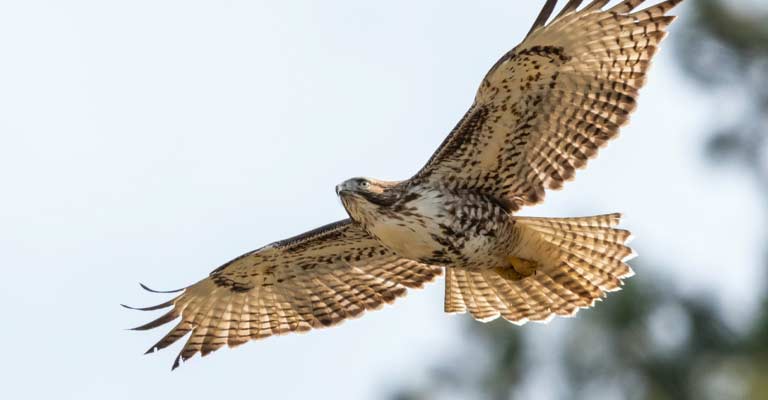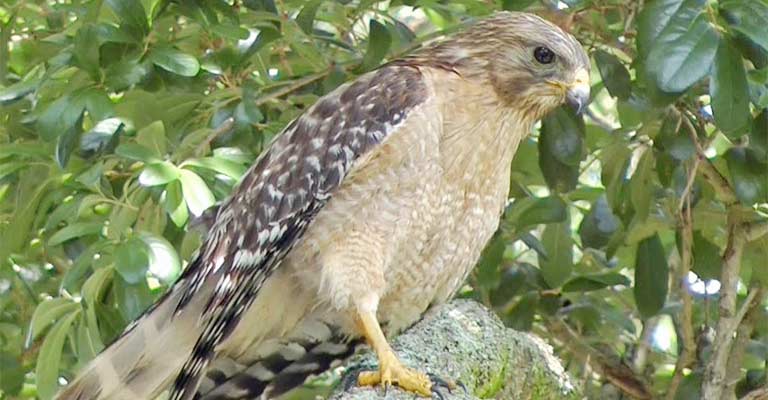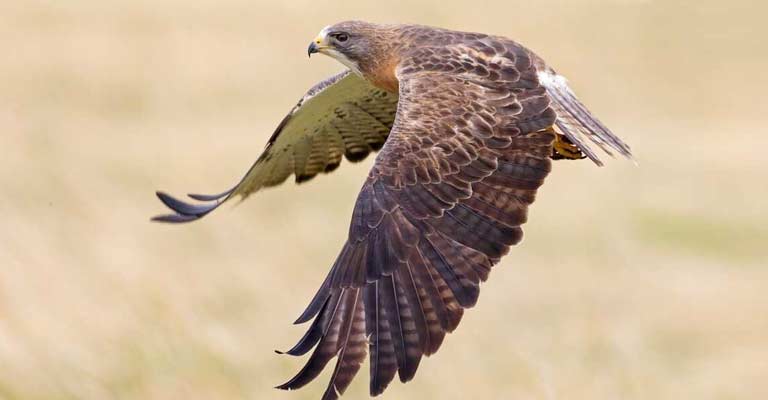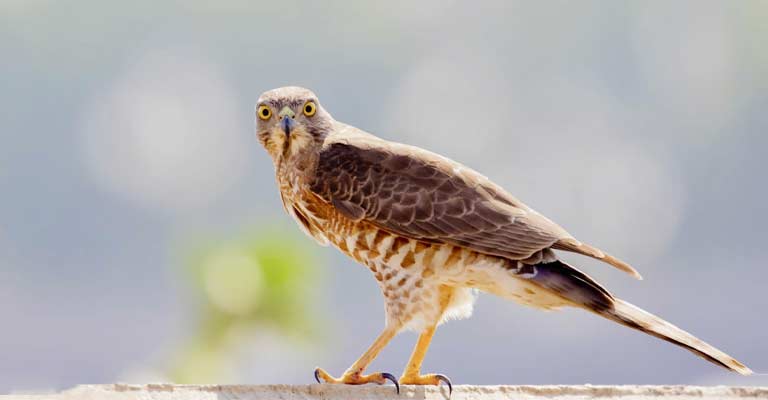Hawks, revered members of the Accipitridae family, stand as iconic symbols of power and grace in the avian realm.
These birds of prey, characterized by sharp talons, keen eyesight, and impressive aerial prowess, have captured the fascination of humans throughout history.
Found in diverse habitats worldwide, from open grasslands to dense forests, hawks showcase adaptability and versatility. As skilled hunters, their role in maintaining ecological balance by controlling populations of rodents and other prey species is crucial.
This introduction sets the stage for a deeper exploration into the fascinating biography of hawks, unraveling their behaviors, unique traits, and ecological significance.

Identifying Characteristics of Hawk
Identifying a hawk in the wild can be an exhilarating experience for birdwatchers and nature enthusiasts. These magnificent birds of prey exhibit distinct characteristics that set them apart from other avian species.
Here are eight key points to help you identify a hawk:
Shape and Size

Hawks typically have a robust and muscular build, characterized by broad wings and a relatively short tail.
Their bodies are designed for swift and agile flight, allowing them to navigate through various terrains with ease. In comparison to some other raptors, hawks are medium to large-sized birds.
Wing Shape

Examining the shape of a hawk’s wings can provide valuable clues for identification. Hawks often have broad, rounded wings, ideal for soaring and gliding.
This wing structure aids them in hunting by allowing for sudden and rapid dives to catch prey. Sharp-shinned hawks, for instance, have shorter wings adapted for maneuvering through dense vegetation.
Coloration and Markings
The coloration of a hawk’s plumage can vary widely among species, but many display a combination of dark and light feathers.
Look for distinctive markings, such as bars on the tail or streaks on the breast. The red-tailed hawk, for example, is known for its namesake reddish tail, while the Cooper’s hawk exhibits a bluish-gray back and red eyes.
Facial Features

Pay close attention to the facial features of a hawk. Their hooked beaks are sharp and powerful, designed for tearing into prey.
Additionally, hawks often have keen, forward-facing eyes, providing excellent binocular vision for hunting. The intensity of their gaze is a characteristic feature that sets them apart from other birds.
Habitat and Location
Hawks inhabit diverse environments, from open fields and grasslands to forests and urban areas.
Different species may prefer specific habitats, so considering the location where you spot the bird can help narrow down the possibilities. Red-shouldered hawks, for instance, are often found near water sources in wooded areas.
Flight Pattern

Observing a hawk’s flight pattern can offer valuable insights into its identity. Hawks are known for their graceful soaring and gliding, often using updrafts and thermals to stay aloft.
They may also engage in hovering behavior while hunting. Cooper’s hawks, on the other hand, are agile fliers with quick, powerful wing beats.
Call or Vocalization
Each hawk species has a unique vocalization, ranging from high-pitched screams to sharp whistles. Familiarizing yourself with these calls can aid in identification.
Red-tailed hawks, for example, produce a distinctive scream often associated with wilderness settings and movies.
Behavior and Hunting Style

Hawks are skilled hunters, and their hunting techniques can vary. Some species, like the red-tailed hawk, prefer perching and patiently scanning the surroundings for prey.
Others, like the peregrine falcon, are renowned for their high-speed dives, or “stoops,” to catch fast-flying birds in mid-air.
Identifying a hawk involves a holistic approach, considering aspects such as size, shape, coloration, habitat, flight pattern, vocalizations, and behavior.
By combining these observations, birdwatchers can enhance their ability to distinguish between different hawk species and appreciate the diversity within this remarkable group of birds.
Taxonomy of Hawk
Here is a table outlining the taxonomy details of hawks based on the provided information:
| Taxonomic Level | Classification |
| Domain | Eukaryota |
| Kingdom | Animalia |
| Phylum | Chordata |
| Class | Aves |
| Order | Accipitriformes |
| Family | Accipitridae |
This table represents the hierarchical classification of hawks, starting from the broadest category (domain) and progressing through more specific taxonomic levels, ultimately reaching the family level (Accipitridae).
Here is the species of this mighty bird:
Sharp-shinned Hawk

The Sharp-shinned Hawk, with short wings and a long tail, excels in rapid, agile flight. Often found in wooded areas, it preys on small birds with precision, showcasing its remarkable adaptability.
Red-shouldered Hawk

Distinguished by its reddish shoulders and loud calls, the Red-shouldered Hawk prefers wooded habitats near water. This bird exhibits a characteristic soaring flight and is an adept hunter of amphibians and small mammals.
Harris’s Hawk

Harris’s Hawk, a unique social raptor, is marked by its striking facial markings. Known for cooperative hunting, these hawks display intelligence and teamwork, making them stand out among their counterparts in the bird-of-prey community.
Osprey

The Osprey, often found near water bodies, is recognized for its remarkable fishing prowess. Its reversible outer toes and powerful talons enable it to catch fish with precision, showcasing a specialized hunting technique that sets it apart.
Buteo

The term Buteo encompasses a diverse group of hawks, characterized by their robust build and broad wings.
These birds of prey, including various species like the Broad-winged Hawk, are skilled hunters, utilizing their soaring abilities to cover vast territories during migration.
Rough-legged Buzzard

The Rough-legged Buzzard is a bird of prey adapted to Arctic tundras. Named for its feathered legs, it is a powerful hunter, often seen hovering over open landscapes.
With keen eyesight, it preys on small mammals and birds, showcasing remarkable adaptability to harsh northern climates.
Ferruginous Hawk

The Ferruginous Hawk, characterized by its rust-colored plumage, is a large raptor found in North America. Well-adapted to open habitats, it primarily preys on small mammals.
Its impressive size and striking appearance make it a captivating species among bird enthusiasts.
Swainson’s Hawk

Swainson’s Hawk is a long-distance migrant, traveling between North and South America.
Recognized by its distinctive plumage, it is often seen in grasslands. This hawk is an adept hunter, capturing insects, rodents, and small birds with its agile flight.
Accipiter

Accipiters, including the Sharp-shinned Hawk and Cooper’s Hawk, are agile forest raptors. With short wings and long tails, they navigate dense vegetation with ease, preying on smaller birds.
Their remarkable speed and stealth make them efficient hunters in wooded environments.
Shikra

The Shikra, a small accipiter found in Asia and Africa, is known for its swift flight and sharp hunting skills. With a preference for wooded habitats, it preys on small birds and insects.
Its adaptability to urban areas showcases its ability to coexist with human environments.
Madagascar Harrier-Hawk

Endemic to Madagascar, the Harrier-Hawk is a unique species adapted to diverse habitats.
With distinctive markings and a powerful build, it is a skilled hunter, preying on a variety of prey including small mammals and birds. Its presence contributes to the island’s rich avian biodiversity.
Goshawk/Sparrowhawk

Goshawks and Sparrowhawks, both belonging to the Accipiter genus, are agile forest-dwelling raptors. Known for their rapid flight and ambush hunting, they target smaller birds and mammals.
These birds exhibit a wide distribution, showcasing their adaptability to various ecosystems around the world.
Each of these hawk species exhibits unique traits and adaptations, allowing them to thrive in different environments and contribute to the rich diversity of birds of prey.
From the iconic Red-tailed Hawk to the cooperative Harris’s Hawk, these species showcase the incredible versatility and evolutionary success within the hawk family.
Hawk Life History
Hawks, belonging to the family Accipitridae, are formidable birds of prey known for their keen eyesight, powerful talons, and soaring flight. Let’s check out all the details of their life history:
Food

Hawks are carnivorous predators with a diverse diet. Their food preferences vary among species but commonly include small mammals, birds, reptiles, and insects.
The Red-tailed Hawk, for example, is known for its ability to capture rodents, while the Osprey specializes in catching fish with its powerful talons.
Habitat
Hawks exhibit remarkable adaptability to different habitats. From open grasslands and deserts to dense forests and urban areas, various species have evolved to thrive in diverse ecosystems.
The habitat preferences of hawks are often influenced by their hunting strategies and the availability of suitable prey.
Range Map

The range of hawks spans across continents, with different species occupying specific geographic areas.
Range maps illustrate the distribution of each species, providing valuable insights into their migratory patterns and the regions they inhabit during different seasons.
Nesting

Hawks invest significant effort in building nests for breeding purposes. Nests are constructed on elevated locations such as trees or cliffs, providing a strategic vantage point for hunting and monitoring the surroundings.
The construction and maintenance of nests are often collaborative efforts between breeding pairs.
Here is all the details of Hawk’s nesting habits:
| Nesting Details | Facts |
| Clutch Size | Varies by species, typically 1 to 5 eggs |
| Number of Broods | Usually one per breeding season |
| Egg Length | Range from approximately 2 to 3 inches |
| Egg Width | Range from approximately 1.5 to 2 inches |
| Incubation Period | About 28 to 35 days |
| Nestling Period | Approximately 40 to 50 days, varying by species |
| Egg Description | Generally elliptical, with colors ranging from white to pale blue or greenish hues |
| Nest Construction | Built by both males and females, using sticks, twigs, and lined with softer materials |
| Nest Location | Elevated locations such as trees, cliffs, or man-made structures |
| Parental Care | Both parents share incubation and feeding responsibilities |
| Fledgling Independence | Young hawks become independent after the nestling period, but parents may continue to provide support |
| Nest Reuse | Hawks may reuse nests in successive breeding seasons with renovations as needed |
This table provides a general overview of nesting details for hawks, highlighting key aspects such as clutch size, incubation period, nest construction, and parental care.
Breeding

Breeding behavior varies among hawk species. Courtship displays, intricate aerial maneuvers, and vocalizations are common aspects of their reproductive rituals.
Female hawks typically lay a clutch of eggs, and both parents share responsibilities in incubation and raising the young, fostering a sense of family dynamics.
Diseases
Hawks can be susceptible to various diseases, including avian influenza, West Nile virus, and lead poisoning from ingesting lead ammunition. These health threats can impact their populations and ecological roles.
Vigilant monitoring and research help identify and understand diseases affecting hawks.
Treatment
Efforts to treat diseased or injured hawks often involve rehabilitation centers and wildlife veterinarians. Treatment may include medical care, rehabilitation exercises, and, in some cases, release back into the wild.
Additionally, addressing environmental factors contributing to diseases is crucial for long-term health.
Conservation

Conservation initiatives play a pivotal role in safeguarding hawk populations. Habitat preservation, reducing human-wildlife conflicts, and mitigating the use of harmful substances like lead ammunition contribute to their well-being.
Public awareness and community involvement are vital components of successful conservation strategies.
The life history of hawks is a captivating narrative of adaptation, survival, and the intricate balance between predator and prey.
Understanding and appreciating their ecology, behaviors, and the challenges they face underscore the importance of conservation efforts to ensure the continued existence of these majestic birds in our natural world.
10 Fun Facts About Hawk
Hawks, the formidable birds of prey belonging to the family Accipitridae, are fascinating creatures with a myriad of interesting traits. Here are 10 fun facts about these majestic raptors:
- Keen Eyesight: Hawks possess exceptional eyesight, allowing them to spot prey from high altitudes. Their eyes are adapted for both long-distance focus and low-light conditions, making them efficient hunters even during dawn or dusk.
- Swift Flyers: Known for their aerial prowess, hawks are agile and swift flyers. They can reach impressive speeds, enabling them to execute precise maneuvers during hunting and navigating through various terrains.
- Territorial Behavior: Hawks are territorial birds, fiercely defending their nesting territories. Intricate aerial displays and vocalizations are common methods employed to establish dominance and deter potential threats.
- Diverse Diet: While many hawks are renowned for their rodent-hunting skills, their diet is diverse. Depending on the species, hawks may consume birds, insects, reptiles, and even fish. This adaptability contributes to their success in various ecosystems.
- Distinctive Calls: Each hawk species has its own unique call or vocalization. The Red-tailed Hawk, for instance, is often recognized by its characteristic scream, a sound that is synonymous with vast open landscapes in popular culture.
- Monogamous Pairs: Hawks typically form monogamous pairs, and breeding pairs often stay together for multiple breeding seasons. The strong bond between mates is evident in their cooperative efforts in nest-building, incubation, and raising offspring.
- Migratory Marvels: Several hawk species are migratory, covering impressive distances during their annual journeys. The Broad-winged Hawk, for example, undertakes a remarkable migration, often forming large flocks called “kettles.”
- Powerful Talons: Hawks are equipped with powerful talons designed for grasping and capturing prey. These sharp, curved claws, combined with a strong grip, enable them to catch and carry prey efficiently.
- Renowned Species: Some hawk species have achieved notoriety in cultural contexts. The Peregrine Falcon, a type of hawk, is recognized as the fastest bird, reaching speeds of over 240 mph during its hunting stoops.
- Conservation Ambassadors: Hawks play a crucial role in maintaining ecological balance by controlling populations of rodents and other prey species. Understanding and appreciating their importance contributes to conservation efforts aimed at protecting these magnificent birds.
Hawks are remarkable creatures with a blend of physical adaptations, behavioral traits, and ecological significance that make them both captivating and essential components of the natural world.
Wrapping Up
Hawks embody a captivating blend of strength, adaptability, and ecological significance.
From their keen eyesight to aerial prowess, territorial behaviors, and migratory marvels, these majestic birds of prey continue to fascinate and contribute to the delicate balance of our ecosystems.
Whether soaring through the skies or fiercely defending their territories, hawks serve as powerful symbols of nature’s complexity and resilience.
Understanding and appreciating their unique traits underscore the importance of conservation efforts to ensure the continued existence and well-being of these remarkable raptors.